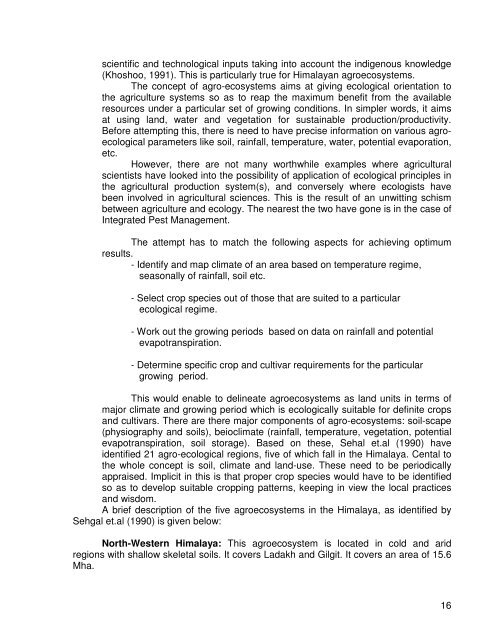Pandit Govind Ballabh Pant Memorial Lecture: II
Pandit Govind Ballabh Pant Memorial Lecture: II
Pandit Govind Ballabh Pant Memorial Lecture: II
You also want an ePaper? Increase the reach of your titles
YUMPU automatically turns print PDFs into web optimized ePapers that Google loves.
scientific and technological inputs taking into account the indigenous knowledge<br />
(Khoshoo, 1991). This is particularly true for Himalayan agroecosystems.<br />
The concept of agro-ecosystems aims at giving ecological orientation to<br />
the agriculture systems so as to reap the maximum benefit from the available<br />
resources under a particular set of growing conditions. In simpler words, it aims<br />
at using land, water and vegetation for sustainable production/productivity.<br />
Before attempting this, there is need to have precise information on various agroecological<br />
parameters like soil, rainfall, temperature, water, potential evaporation,<br />
etc.<br />
However, there are not many worthwhile examples where agricultural<br />
scientists have looked into the possibility of application of ecological principles in<br />
the agricultural production system(s), and conversely where ecologists have<br />
been involved in agricultural sciences. This is the result of an unwitting schism<br />
between agriculture and ecology. The nearest the two have gone is in the case of<br />
Integrated Pest Management.<br />
The attempt has to match the following aspects for achieving optimum<br />
results.<br />
- Identify and map climate of an area based on temperature regime,<br />
seasonally of rainfall, soil etc.<br />
- Select crop species out of those that are suited to a particular<br />
ecological regime.<br />
- Work out the growing periods based on data on rainfall and potential<br />
evapotranspiration.<br />
- Determine specific crop and cultivar requirements for the particular<br />
growing period.<br />
This would enable to delineate agroecosystems as land units in terms of<br />
major climate and growing period which is ecologically suitable for definite crops<br />
and cultivars. There are there major components of agro-ecosystems: soil-scape<br />
(physiography and soils), beioclimate (rainfall, temperature, vegetation, potential<br />
evapotranspiration, soil storage). Based on these, Sehal et.al (1990) have<br />
identified 21 agro-ecological regions, five of which fall in the Himalaya. Cental to<br />
the whole concept is soil, climate and land-use. These need to be periodically<br />
appraised. Implicit in this is that proper crop species would have to be identified<br />
so as to develop suitable cropping patterns, keeping in view the local practices<br />
and wisdom.<br />
A brief description of the five agroecosystems in the Himalaya, as identified by<br />
Sehgal et.al (1990) is given below:<br />
North-Western Himalaya: This agroecosystem is located in cold and arid<br />
regions with shallow skeletal soils. It covers Ladakh and Gilgit. It covers an area of 15.6<br />
Mha.<br />
16











